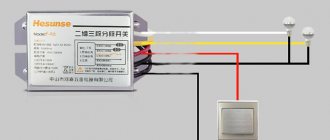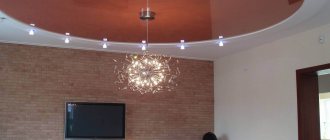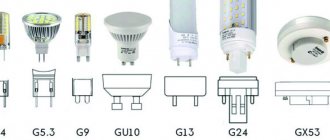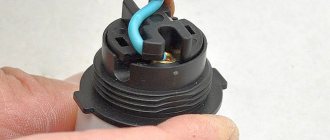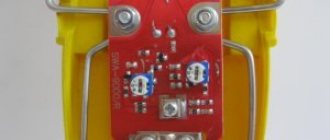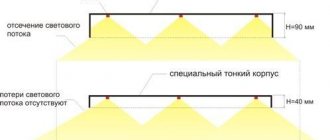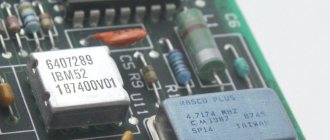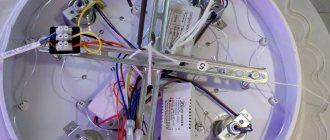It is unnecessary to say what a big role vision plays for us, and at the same time the light with which we see. That is why lighting devices play such a significant role in interior design for us. In some places they are very simple, like wall lamps or ceiling lamps, and in others they are more elegant. And the more complex the lighting device, the more complex the connection diagram it will require, which in itself is a completely understandable conclusion. For example, a chandelier, it usually implies the ability to connect two circuits with lamps, thereby changing the illumination in the room from dim, so to speak intimate, to bright light. Controlling a chandelier via three wires
We are all already accustomed to the fact that a chandelier with two modes is controlled via three wires. In fact, in this case, two parallel circuits are implemented for each group of chandelier lamps. Each of the circuits begins with a switch, thereby switching the desired circuit and turning on the desired lamps. This option can be called generally accepted. It is simple and can be implemented with minimal investment - one additional wire from the switch to the chandelier. This option is described in detail in one of our articles “Connecting a chandelier”. However, this option also has disadvantages; this is precisely the third wire, which we mentioned as an advantage of minimizing investments in the connection circuit. After all, imagine this option, when the walls are plastered and wallpaper is pasted. Here it is unlikely that it will be possible to route the third wire quickly and without problems. There are two options here. This is to buy a chandelier that will have several lighting modes and be controlled from a remote control. The second option is to implement a circuit that would provide step-by-step switching for each group of lamps, depending on the number of switchings of the control switch. It is these options that we will talk about further...
Connection diagram for chandelier with remote control
The main design element is the signal switching controller. Most often, this is a non-separable box that contains information about connecting LEDs - LED, or halogen lamps - H. On Chinese controllers, the information may be in hieroglyphs with poor duplication in English.
The block shows a channel connection diagram
Such devices may be designated “Wireless Switch” or “Control Switch,” which means a switch controlled by a remote control. The most popular models are Y-2E and Y-7E. If one of the models is found, then we can consider ourselves lucky with the controller in the chandelier. Model Y-7E is best suited for home luminaires controlled by remote control.
Its structure includes:
- Three control channels, two of which are 1000 W each, respectively, for halogens and LEDs for a chandelier, one is 200 W for fluorescent light sources;
- Switching system for input alternating voltage 240V;
- A receiver that provides capture of the control signal from the remote control at a distance of up to 8 m.
For your information! More powerful models can use three 1 kW channels.
The diagram for connecting different types of lamps to their channel is shown below.
At the input to the controller, a pair of blue and brown wires is used; this is the standard color for the input voltage circuit. If you have doubts about the correct connection of the ceiling wires to the microcontroller unit, you can additionally look for the INPUT or input sign.
Important! The antenna is connected separately; as a rule, it is a short piece of wire in a dense white braid. You can't touch him.
How to connect an LED chandelier
The very fact of using a universal controller in a lighting device simplifies the task, since the device paired with a remote control can be removed from the chandelier and used in any other lamp. In addition, it is possible to use a chandelier for one type of light source - halogen or LED, without compromising the design. You just need to guess which pair of contacts corresponds to the button on the remote control.
Block for LED chandelier without remote control
It’s another matter if the LED chandelier is connected using a monoblock that has only one pair of pins. As a rule, the input to the block is made with wires of any color. Since the controller is not grounded, there is not much difference where to solder the zero and phase. At the output of the Chinese there is a pair of colored wires without markings.
Advice! Even if the box is marked “+” and “-”, before connecting the wires going to the LED lamp, you must check the polarity with a multimeter.
In addition, before assembling and hanging the chandelier, you need to check how the remote control works and whether the unit heats up under load. Separate tests are carried out on the range of signals from the remote control.
How to connect a halogen chandelier with a remote control
The connection procedure is no different from the LED version. The only addition is the installation of a step-down transformer for the halogen lamp.
The appearance of the step-down transformer is shown in the photo.
The trance power should be greater than the total lamp consumption
The number of electronic converters is equal to the number of halogens; as a rule, one or two blocks are used for each group of lamps, depending on the power and connection diagram.
How to connect a chandelier correctly?
If you pay attention to the five-arm chandelier, it has a fairly large number of wires, so inexperienced craftsmen avoid such lighting devices. However, there is nothing complicated in the process of connecting the wires coming from the distributor to such a lamp
However, there is nothing complicated in the process of connecting the wires coming from the distributor to such a lamp.
Since the determination of the phase of the wires is carried out when the power supply is turned on, it is necessary to ensure that the bare ends of the wires do not touch. If necessary, they must be carefully moved in different directions, having first turned off the shield
First of all, you need to deal with the wiring on the ceiling, which in a standard situation has three wires:
- L1 – phase of the first switch key;
- L2 – phase of the second key;
- N – zero.
If the wires are the same color, then using a voltage indicator, the identity of each is determined, i.e., phases L1 and L2. Accordingly, the remaining core will be zero.
Next, you can move on to the process of forming contact nodes. Let's consider the example of a five-arm chandelier, which has 10 wires: brown phase conductors - there are 5 of them, and the same number of blue zero wires.
Most Chinese-made chandeliers are not equipped with the necessary connections, so you will initially need to determine how many groups the light bulbs will be divided into. Each lamp socket has two conductors of different colors - black or blue and brown
This lamp has one undeniable advantage - the combination of light bulbs can be made at your discretion. According to the diagram described below, the first group includes two light bulbs, the second - the remaining three.
Wiring diagram for a five-arm chandelier. Explanation of symbols: L – phase of the general power supply of the switch, L1 and L2 – phase wires of a series of light bulbs (red), neutral cable N – blue
Based on this diagram, the connection of a five-arm lighting device is carried out in several stages. Initially, a pair of brown wires is assembled into one unit.
It is advisable that lamps included in the same series are connected in parallel. We call this twist L1.
The next step is to twist the unused three brown wires in a similar way. This will be the L2 series. Next, the resulting two nodes are inserted into WAGO two-wire terminal clamps.
It is better to make all contacts using terminal clamps rather than by twisting. You can use either a common clamping module or an individual design
At the next stage, the blue wires are twisted and connected to a three-wire terminal.
The order of connection does not matter. The combination can be 3+2 or 2+3. This will be the neutral node - N.
The only disadvantage of Vago terminal blocks is that they are not treated with quartz paste, which protects the contacts from oxidation. However, this problem can be solved by purchasing such a composition and douching it into the clamp yourself
As a result, the output produces 3 connection nodes: the phase of the first and second groups of lamps - L1 and L2, the common neutral node - N. Taking into account the marking of the wires, they must be connected to the corresponding lines on the ceiling.
There are two phase conductors coming out of the lamp (L1, L2), and there will be only one neutral wire (N) and it is connected to the second contact of the socket
At the final stage, it is necessary to lay all the wiring in the block of the chandelier bowl and install it. Fastening is carried out in one of the following ways: hung on a hook or screwed with screws. Next, the decorative plugs of the lamp are tightened.
Pass-through light switch
To control the lamps from two places, they do not install simple switches; pass-through SWITCHES are used, so named according to the principle of operation. Below is a visual comparison of their circuits.
The switch simply breaks or shorts the phase conductor passing through it, de-energizing or lighting the lamps.
The switch is designed differently, inside it, with each key press, the phase conductor is connected to one or the other internal contact. In this case, the phase does not break, but only transfers to the adjacent contact - because of this, the device is also called a changeover switch. Read on to find out why it is needed and how it is used.
Connection diagram for an infrared heater via a mechanical thermostat
This, in my opinion, is the most optimal connection diagram for an infrared heater. You can use any - mechanical, electromechanical or digital (electronic).
When implemented, many of the most important disadvantages of previous methods are eliminated.
In this case, you will need to carry out the electrical wiring from the electrical panel to the installation site of the infrared heater in advance. An option with external installation is possible, for example, in a cable duct - but this method is less safe and often spoils the appearance of the room.
Electrical wiring is laid from the electrical panel or other source to the thermostat, and from there it goes to the heater.
The most difficult thing here is connecting the wires inside the regulator. As an example of the most affordable and widespread mechanical thermostat, I took the BALLU BMT-1 model. His example, the diagram below, shows how to correctly connect the conductors inside.
Most mechanical thermostats have similar installation patterns, you can see this in the example of the ZILON model, which we reviewed earlier. In addition, instead of mechanical ones, digital (electronic) sensors are often used; they have a greater number of operating modes, adjustment options and external appearance. An installation example of one of them is available HERE.
Main disadvantages
— Larger financial costs than previous schemes
For implementation, it is necessary to first carry out the electrical wiring, purchase additional electrical equipment, a thermostat and cable.
— The need for additional electrical work
The need for preliminary work on laying cables and installing regulators requires the involvement of appropriate electrical specialists. Or the knowledge and skills, and most importantly the time, to do this work with your own hands.
— Impossibility of installing several IR heaters or one powerful one
The thermostat contacts rarely allow the possibility of connecting to it a current greater than 10A, in rare cases 16A. Accordingly, the maximum total power of heaters should not exceed 2-3 kW.
Advantages of connecting an IR heater via a thermostat
— Possibility of automatic adjustment of room temperature
You get a fully automated heating system. Which itself maintains the temperature, turns on and off at the programmed time.
— Ease of management
You choose the installation location of the thermostat yourself and its location is not tied to the installation location of the heating elements.
— Completely safe hidden electrical wiring
Electrical wiring is done in advance. In this case, you can choose the correct cross-section of conductors, the type of their connection in junction boxes, etc. In this case, all conductors are hidden, significantly reducing the likelihood of cable damage.
- Appearance
Cables hidden behind the wall decoration and the ability to choose the appearance of control devices allow you to preserve the original appearance of the interior and even decorate it.
CONCLUSION: If we ignore the installation difficulties and additional costs for equipment and electrical wiring, this is an almost ideal option in terms of functionality for small rooms. Where one or two heaters are often enough, the total current consumption of which does not exceed 10-16A to maintain a comfortable temperature, there is no better way to think about it.
If you have the task of heating a large room using several electrical heating devices or energy-intensive, powerful models, the best option for you is to connect through a thermostat and contactor.
This is interesting: Connection diagram for a self-retaining relay for a gas boiler
Wiring for turning off lights from two places
From the logic of operation it is clear that cables with a larger number of cores are supplied to the places where the light is turned on than for the switch. The image below schematically shows standard electrical wiring for turning on the light from 2 places, using a junction box.
Since everything is switched in an electrical junction box, three-core cables are laid from the devices to it (in an apartment or private house this is VVGng-LS 3x1.5mm.sq.):
— Up to each switch mechanism
- To the lamp
— To the electrical panel or the nearest electrical box
A total of 4 cables are used. Be careful, if there are more than two controls, this rule does not work.
Ways to use semiconductors in chandelier lighting control
The use of transistors is becoming much more popular. Their performance is characterized by long-term operation and high switching frequency. Several controls are provided for review and selection. Meter based control
Counting pulses are the basis for lighting control. The first one is usually responsible for resetting the counter. Repeated – for serial connection of lamps.
Each new press of the switch activates a new pair or group of lamps. To reset the pulses from the counter, it is enough to pause for a third of a minute.
Shift register in control system
The principle is already contained in the name itself. The impulse, hitting the starting point C, is transmitted further along the chain to D and 1.
The incandescent lamp circuit is connected and operates on the same principle as in the example with a meter.
To search for breaks in a faulty electrical network, use special
devices for detecting hidden wiring
. As an alternative method, this can be done using a radio or smartphone.
You can calculate the level of room lighting by knowing the luminous flux of the lamps used.
What to look for when choosing a voltage stabilizer can be found here
Thyristor control system
Rectifier VD6-VD9 powers the entire control circuit. When the switch is turned to the “On” position, the first lamp in the EL3 circuit lights up.
Next, the capacitors charge and accumulate the high and low signal so that DD1 keeps the transistor and thyristor off. When the switch is turned to the "Off" position, the capacitor is recharged.
Microcontrolling a chandelier
The microprocessor is equipped with software. Thanks to this, the operating principle can be unique. After all, such a scheme may have additional built-in functionality in addition to conventional lighting. Nevertheless, the same scheme as in previous cases is taken as a basis.
The connection and control diagrams for the chandelier do not have such significant differences.
Even the electronic system remains true to the original principle.
But what really doesn’t add up is the quality and durability.
For the “Electroeffluvial chandelier” scheme
An electroeffluvial chandelier, an ionizer, is an emitter of negative air ions that can increase the saturation of the air in a home room with air ions. The design consists of a square base made of 2 mm wire and a mesh of 1 mm wire, at the nodes of which pointed needles of wire with a diameter of 0. 3 mm. Four conductors, soldered together, go from the corners to the center of the square. High voltage is applied to this point, and through the insulator the chandelier
suspended from the ceiling. The thyristor high-voltage converter consists of a step-down power transformer T1, a rectifier on VD1, a storage capacitor C1, a high-voltage transformer T2 and a thyristor control unit - III winding T1, R2, VD2. Details. Instead of the KU201L thyristor, you can use the KU202N. The use of triacs (for example, KU208) is unacceptable. Any small-sized transformer T1 from a tube radio (wound independently on a Ш19 core, set thickness 30 mm: I winding - 2120 turns of PEL-0.2 wire; II winding - 2120 turns of PEL-0.2; III winding - 66 turns of PEL-0 ,2). zu on KT707 circuit T2 - high-voltage coil from the electronic ignition unit of the Tral chainsaw or magneto. Can be made from a core and a high-voltage coil from a TV type CNT-35 (“Record-66”, “Rassvet”). Wind the primary winding yourself with PEL-0.51 wire in the amount of 200 turns. Instead of a high-voltage column VT-18/0.2, you can use 5GE600AF. Insulate high-voltage wires only with PVC tape. Before turning on the converter for the first time, you must connect a 220 V lamp in the gap at point A. If after switching on the lamp lights up, swap the terminals of winding III T1. If after this a high voltage appears, but the lamp continues to glow at least slightly, increase the resistance of resistor R2. There should be no odors when the air ionizer is operating - this is a sign of the appearance... See description of the diagram...
Dependent load switching
Some of the electrical and radio devices work together. For example, when using an active television antenna, it would be convenient if the power supply of the antenna amplifier turned on itself when the TV was turned on and automatically turned off when it was turned off. This eliminates the need to monitor the status of the slave's auxiliaries when the master is turned on.
It is also convenient to have a small backlight behind the TV in the evening - this will tire your eyesight less when watching TV for a long time. This task is performed by the one shown in Fig.
When a current appears through the load connected to the XS1 sockets, the voltage removed from the autotransformer T1 is rectified by diodes VD1, VD2 and, through resistor R1, is supplied to control the switch VS1. In this case, the voltage drop across the VS1 switch does not exceed 2V. In this scheme, it is possible to remotely control the switching on of devices, if most importantly, for example, a TV has this ability; in standby mode, the TV consumes a small current, which is not enough to turn on the electronic switch.
The T1 transformer is homemade and is made on the basis of a widely used telephone transformer used in older models of telephone sets. To do this, you will need to remove one upper winding from it and in its place place turns of PEL-2 wire with a diameter of 0.5 mm. The remaining windings are connected according to the voltage-increasing autotransformer circuit. This increases the minimum sensitivity of the device. For the transformer, a ferrite magnetic core MNM1 of standard size W5x5 mm can also be used.
The sensitivity of the circuit to the minimum load current also depends on the number of turns in the primary winding. Any diodes with a current of at least mA can be used in the circuit.
The resistor used is MLT, polar electrolytic capacitors type K or similar. The printed circuit board for the circuit was not developed, and the installation is carried out by volumetric installation. The entire structure is housed in a plastic case with dimensions 90 x 50 x 30 mm. It is convenient to set up the device with a lamp and a voltmeter connected to the XS2 sockets and comes down to selecting the value of the resistor R1 so that the VS1 key is fully open with a real load connected to the XS1 sockets.
The maximum permissible load power of the master device connected to the XS1 sockets is W. It can be increased by increasing the diameter of the wire in the primary winding of the autotransformer, while the number of turns in the primary winding can be reduced. The above circuit does not consume energy in standby mode. It is easier to manufacture and contains fewer parts compared to a device for a similar purpose. If it is necessary to turn on a more powerful load of the slave device, you can use an intermediate relay connected to the XS2 sockets with contacts for the required current, or you can assemble a similar switch circuit with a more powerful thyristor (Fig.
Using a counter
Another circuit is built on logical elements. The essence of the idea is that you apply pulses and logical units alternately appear at its output. They are used to turn on semiconductor switches such as transistors.
Switching of groups of lamps occurs when the switch is quickly switched (on/off), so clock pulses are received at the input of counter C and logical units appear at the output. Work algorithm:
- EL1 & EL
- EL1 & EL3 & EL
- EL1&EL2&EL3&EL
The counter is reset when a signal is applied to input R. To do this, turn off SA1 for 15 seconds.
- Counting pulses are generated by DD3.
- The first switching on, a logical zero is formed at the output of DD3, is held from C2.
- A short switch discharges the capacitor and a logical one appears at the output of DD3. Element DD2.1 switches on the rising edge at the counting input. And so on with each short-term opening of SA2.
We use diodes
The first idea is to use a diode circuit. The bottom line is that several switches installed in parallel turn on the lamps through diodes, and diodes are also installed in front of the lamps. Since the diode passes only one half-wave of the sinusoidal voltage of the household electrical network (in this case), the lamp in front of which the diode is switched on in the corresponding direction will turn on.
The disadvantage of this circuit is that only half the supply voltage is supplied to each lighting group. Incandescent lamps will work when turned on in this way, but fluorescent or LED lamps, if they turn on, such power will lead to their premature failure. Incandescent lamps will flicker at the frequency of the mains supply, for Russia this is 50 Hz, this leads to increased fatigue of people in the room, as well as headaches and general ailments. This light cannot be used in residential areas.
Ceiling chandeliers - varieties
According to the number of lampshades, there are:
- chandeliers with one shade or lampshade (single-arm);
- with two shades or lampshades (double-arm);
- three-arm (with three shades), etc.
Basically, the number of lampshades depends on the style of execution (classic, loft, modern, etc.) and design. Moreover, the more shades and lamps on a chandelier, the greater the lighting power and, as a rule, the greater power consumption of electricity. The larger the area a given lighting device can illuminate.
By type of control, chandeliers are divided:
- wired control (two or three wire connection, plus a grounding contact if the chandelier has a metal structure);
- wireless control (via radio or from a phone via Bluetooth);
- combined options.
If you haven't bought a chandelier yet, just plan to do so
In this case, it will be very important to determine what type of wiring is installed in your apartment or house. The choice of a chandelier with a suitable connection diagram and control option depends on this
12 connection diagram options
Below is a table to help you make this choice. It is enough to determine what type of wiring you have and what switch is installed. If you select the right chandelier, no major alterations or interventions will be required in your existing wiring diagram. With the exception of some options, where there is a “change required” mark. We will discuss these changes below when we take a closer look at connecting the chandeliers of these models.
To decide on the choice of chandelier and connection option
- You need to determine your wiring type (2, 3 or 4 wire). Just look at the ceiling and see how many wires you have coming out of the ceiling in the place where the chandelier is attached.
- Which switch is used to control the lighting (in table 1, 2-key or dimmer).
- We select from the table the desired functions that correspond to the option number of your electrical wiring.
- And next to it, in the column, we see which chandelier performs these tasks.
You need to pay attention!
If you have 3 wires coming out of the ceiling, then in this case your wiring may have 2 “scenarios”
The difference will be that according to one option, one “phase” will come from the switch to the chandelier, and in the other option there will be two – “L1” and “L2” (pay attention to the number of keys on your switch)
If your wiring has 4 wires, then you can use any type of chandeliers and any controls here.
How best to connect the wires
As a rule, electricity does not forgive mistakes, even small ones, sooner or later, but the results will not keep you waiting long.
Basically, the problems relate to poor-quality connections of wires, both in the process of forming groups and in the process of connecting them to electrical wiring. A bad twist will always make itself felt after some time, since the contact is broken and begins to heat up. Based on the latest requirements, when connecting a chandelier to electrical wires, it is undesirable to make twists, although high-quality twisting is not inferior in reliability to terminal connections. Most chandeliers produced nowadays are equipped with similar terminals, moreover, they can be purchased in any department of a hardware store that sells components for electrical wiring.
You need to connect the wires from the chandelier and the switch in the terminal box
Often problems arise due to the fact that a twist of several wires does not fit into the hole. In this case, there is a way out: a conductor no more than 10 cm long is soldered to the twist. If we talk about modern chandeliers, they use a fairly thin wire, so a twist of even 5 wires easily fits into the hole in the clamps.
After the groups (twists) are formed, they are inserted into the terminal block and securely clamped with screws. After this, they begin to connect the chandelier on the ceiling, performing a similar operation with the wires. They are also inserted into the terminal block and securely fixed with the same screws. The most important thing is to correctly connect the neutral and phase groups.
In the video you can familiarize yourself in detail with the process of forming groups of many wires, as well as with their correct connection to the terminal block.
How to connect a chandelier. How to connect wires. Installation in Kyiv 0974288408
Watch this video on YouTube
Installation of chandeliers with remote control
A modern manufacturer of lighting equipment for household needs is trying to make its products universal. The decision is correct; a chandelier designed for several types of lamps will be purchased faster than a product designed only for halogens or LEDs. It is this pair of light sources that will be the optimal combination for a ceiling lamp. Halogen provides powerful and rich lighting at night, while LED ideally illuminates the apartment space in the evening.
The optimal combination is a halogen lamp and two LED backlights
If you remove the decorative trim of a chandelier designed to be controlled from a remote control, you will be able to see several parts and pairs of wires:
- Microblock with a receiver and a controller for switching signals received from the control panel. This is the main unit, the wiring from the halogen and LED lines of the chandelier is connected to it;
- A wiring system, a transformer, necessarily electronic, and a set of halogen lamps;
- LED lamp line power driver unit.
First of all, you need to understand the markings and designations
Of course, the chandelier must come with a remote control and a wiring diagram. Although for many Chinese lamps, information about connecting and calibrating the remote control can be written on a tiny sheet of paper pasted on the back of the decorative cover.
Important! The remote control system for controlling the lamp uses high-frequency radio waves, most often in the 27.1 MHz range allowed for household toys.
This means that if a chandelier of normal quality was purchased and installed, the remote control will allow you to control the lighting from almost anywhere in the apartment. In addition, you will no longer need to point the box in the direction of the chandelier, as many do out of habit developed over years of handling the TV or air conditioner remote control.
Additional features of the remote control and controller
In the above control diagram with three channels of lamps, it is quite acceptable to combine two of them and free one for regulation at a distance by other consumers:
- local chiseled sources;
- electric drives for moving curtains;
- projector;
- additional devices.
To solve the same problem, you can use a more complex controller and a remote control for it. Advanced features will allow you to:
- select the color scheme of the lighting system;
- change lamp switching algorithms;
- adjust the brightness of sources;
- start a timer that performs lighting according to a schedule.
A special place is occupied by controllers that provide remote control of light without a remote control, by issuing commands by voice or clapping your hands.
“Smart Home” Do it yourself - Controlling a chandelier using two wires
Controlling a chandelier via two wires...
As you know, in many houses there are only two wires to the switch, in this case it is possible to turn on the chandelier in the room only as a whole (let’s say six lamps), but I would like to turn on only three light bulbs, and when, say, you need more light, turn on three more. In this situation, you cannot do without a third wire for an additional switch. Or maybe you are not yet going to make repairs and ditch the walls for laying the third wire. There is a way out of this situation; you will only need one module designed specifically for this. It is built directly into the chandelier (you can see how the module is connected in the chandelier in the figure at the end of the page). This module is compatible with all types of electric lamps! This means you can use LED or energy-saving lamps. Everyone knows that: Dimmers are absolutely incompatible with economical fluorescent light bulbs, and yet there are more and more such lamps! In Europe they have simply decided to legally ban the use of incandescent lamps. Three types of firmware were written for this module (three modifications of this module). We will consider each modification separately.
1. Control of the chandelier via two wires, “Normally off”
This module with this firmware modification is best installed in a closet or hallway. We connect the module according to the diagram below. The diagram shows that: One light bulb (or part of the chandelier) is connected directly and turns on every time it is turned on. The second light bulb (or part of the chandelier) is switched on through the module. When you turn it on for the first time, only one light will light up. To turn on or turn off the additional lighting channel, you need to turn off the light with the switch and turn it on again within one second, the second lamp will light up. The lighting turns off in normal mode, as before. The peculiarity of this modification is that the additional channel always starts in the off state.
2. Control of the chandelier via two wires, “Normally on”
This module with this firmware modification is best installed, for example, in the kitchen. When you turn on the light, both lights (both channels) will light up, and if necessary, the light can be dimmed (by turning off the additional channel). We connect the module according to the diagram below. The diagram shows that: One light bulb (or part of the chandelier) is connected directly and turns on every time it is turned on. The second light bulb (or part of the chandelier) is switched on through the module. When turned on for the first time, both channels (main and additional via the module) will light up. To turn on or turn off the additional lighting channel, you need to turn off the light with the switch and, within one second, turn it on again, the second lamp will light up or turn off (depending on what position it was in before). The lighting turns off in normal mode, as before. The peculiarities of this modification are that the additional channel always starts when it is on.
3. Control of the chandelier via two wires “With memory mode”
This module with this firmware modification is the most convenient in my opinion. The last state of the additional channel (on/off) is recorded in the microcontroller, and the next time the light is turned on, the additional channel will restore its previous state. That is, it remembers each of its states. We connect the module according to the diagram below. The diagram shows that: One light bulb (or part of the chandelier) is connected directly and turns on every time it is turned on. The second light bulb (or part of the chandelier) is switched on through the module. To turn on or turn off the additional lighting channel, you need to turn off the light with the switch and, within one second, turn it on again, the second lamp will light up or turn off (depending on what position it was in before). The lighting turns off in normal mode, as before. The peculiarities of this modification are that the additional channel starts in the state in which you last left it. This version of the firmware uses a non-volatile flash memory cell, and if the power goes out, nothing will happen.
Specifications:
Control: From a standard switch Memory: Non-volatile (FLASH) Maximum switched current: 220V - 500 Watt Overall dimensions, LxWxH, mm: 30x30x18 Article number: UL2 Supports work with all types of lamps.
Price: Negotiable.
Upon purchase you will receive: Assembled module, instructions.
To enlarge the image, hover over it
smart-home.do.am
Controlling a chandelier via two wires | Electrics and low voltage
When dealing with repairs and all sorts of finishing and alterations, not every craftsman is able to provide for all the nuances and “little things.” And renovation and finishing work does not always include a complex of major renovations.
This happens very often with light. More precisely - with electrical wiring. For example: they forgot to run an additional wire for the lighting of the living room, or: they changed the wallpaper in the bedroom, but did not scratch the walls so as not to “spread dirt”, but there is no “evening” lighting for the room at all! There are many similar situations, and the modern idea of comfort is already inextricably linked with the wide possibilities of lighting design, with various lighting options. So let's think, because there are no hopeless situations!
Let's start with the most common case. In old apartments, only two wires are connected to the central chandelier, that is, even simple lighting in “two modes” cannot be done. Hammer the ceiling? Hang several sconces on the walls? Not necessary. There are many different “schemes” for controlling a chandelier via two wires - very simple, of medium complexity of implementation and quite serious electronic devices. We will look at the simplest and easiest to repeat switching circuit.
The very principle of “two-position” lighting is very simple, it is enough to reduce the current on the lamps of a lamp or chandelier, and by connecting a diode of sufficient power to the circuit, it will not be difficult to implement two lighting modes.
Using a regular two-key switch, we can turn on our chandelier at “half” power (S1), or at full power (S1 and S2 together). Where is it easier?
But if we add another diode of the same type to our circuit, only turning it on “in the opposite direction,” then the light will turn on when you press any “full-intensity” key, and the second key will turn on the full lighting power again. An additional advantage of such a scheme is that by first turning on the lighting “at full intensity”, we heat up the llama filament, increasing its resistance, and when full voltage is applied, there is no sudden jump in current, as with the usual switching on of cold lamps. Does everyone remember that light bulbs usually burn out the moment they are turned on? So, our circuit will extend the life of incandescent lamps indefinitely!
However, the possibilities of the two-wire circuit are not exhausted. Just a couple of new elements in the circuit make it possible to turn on and off individual groups of lamps.
Quite simple? And the functionality of such a switch is quite at the level - by turning on one switch key, we supply “half” voltage to L1, L2, L3, and lamps L4 and L5 do not turn on at all, since the diode “rectifies” the supply voltage, and the capacitor does not “pass” constant current.
As you can see, you don’t need to be a great specialist or professionally involved in electrical engineering to turn on the light in various configurations, having only a two-wire line at your disposal. To simplify the task even further, the approximate ratio of the power of the connected light bulbs and the capacity of the “control” capacitors:
Of course, these figures are approximate, you can install capacitors with a capacity of ±1.2 µF, it is important that the operating voltage of these devices is NOT LESS than 250V, or better yet, let it be 400V. These are, for example, ceramic capacitors K73-11, but diodes should be selected based on the ratio - 500 W ? 2.5 A, that is, the forward rated current of the diodes must be at least 2.5 A for a 5-arm chandelier with 100 watt bulbs, and the maximum reverse voltage of the diodes must be at least 250 V
In practice, you can use KD202 diodes with letter
index Zh, K, M, R, or any diodes KD203, KD206.
For a chandelier of lower power (say, 3 bulbs of 75 Watt each), you can use a KD226 diode V, G, D, E with a direct transmission current of 1.7-2 A.
The diodes for the presented circuits are mounted directly into the switch body, or in the installation box, as follows: From Figure 4 it can be seen that the diodes are connected “towards” each other to the common terminal of the double switch, where voltage is usually supplied, and the “input” and “output” The circuits are on opposite connectors. Nothing complicated. But the capacitors will have to be “hidden” in the casing or body of the chandelier itself, where the power wires are connected.
I would like to hope that thanks to this material, there will be one less “hopeless” situation during repairs!
Power of one light bulb, W Capacitance of the capacitor in the circuit, uF 100 10 75 7.5 60 6.5 40 4.5
Electrician in the house
Chandelier control
A problem often arises: you bought three to five (or more) arm chandeliers, and you would like to be able to turn on two or three lamps separately and all together. To do this, you need to have three wires connected to the chandelier and then everything is simple - we control the chandelier using a two-key switch. But if there are two wires going to the chandelier and the wiring is hidden, then it’s more difficult...
How to control a chandelier using two wires? The simplest solution is to install a diode and turn on the chandelier through the diode and directly, in the first case the chandelier will shine at full intensity, but the flickering of the chandelier lamps will be slightly noticeable. And in this case, it will not be possible to use energy-saving lamps.
There is also a more complex diode circuit that allows you to control two groups of lamps via two wires. The diagram is shown in the figure above. Unfortunately, this scheme has the same disadvantages.
This circuit works as follows: When you press the S1 key of a two-key switch, the lamp (group of lamps) L1 turns on, current flows through diodes D1 and D3, L2 does not turn on, because diode D2 is turned on in the opposite direction with respect to D3. Accordingly, when you press the S2 key, lamp L2 turns on.
Diodes are selected based on the power of the lamps. For example, a D226 diode will support a lamp (group of lamps) with a power of up to 60 W. Diodes D245, D246 can withstand power up to 2000 W. The reverse voltage of the diodes must be at least 300 V. Diodes D1, D2 are located in the decorative glass of the chandelier near the ceiling, and diodes D3, D4 are located in the switch body.
Now we will look at a scheme that does not have the disadvantages of the previous one.
Two-wire chandelier control circuit
Controlling a chandelier via two wires
The diagram shows:
- L1 is the first group of chandelier lamps.
- L2 is the second group of chandelier lamps.
- S1 - switch.
- T1 - transformer.
- D1-D4 - D202 diodes or KTs402 assembly.
- D5 - diode D226D (B, C, D).
- Relay RES-9, pass. RS4.524.200.
- Capacitor K50-6, 1000 µF, 25V.
Operation of a chandelier control circuit over two wires
When you press the switch key S1, the first group of chandelier lamps L1 lights up. At the same time, voltage is applied to transformer T1, which lowers the voltage to approximately 15V, diode bridge D1-D4 rectifies the voltage. Relay K1 is turned on through normally closed contacts K2.1. Relay K1 switches capacitor C1 to the rectifier with contacts K1.1, the capacitor is charged.
In order to turn on the second group of lamps L2 (in addition to the first), you need to open and close the contacts of switch S1 again. In this case, relay K1 will be de-energized (when S1 opens) and contacts K1.1 will connect the charged capacitor C1 to the winding of relay K2, relay K2 will operate and self-block through its contacts K2.1. In this case, the relay will connect L2 to the network with contacts K2.2.
The time it takes to switch the contacts of switch S1 is determined by the capacitance of capacitor C1; with the indicated capacitance, this time will be at least 1 second.
Scheme details.
L1, L2 - lamps in a chandelier, they can be of any power (the maximum is indicated in the chandelier's passport), it can be either one lamp or several connected in parallel. Lamps can be any - both ordinary and energy-saving.
S1 is a regular single-key switch.
T1 - step-down transformer 220/15 V, with a power of at least 2 W. You can make the transformer yourself - on a Sh12x12 magnetic core, the primary winding is wound on a cardboard frame with PEV-1 wire, 0.08 mm - 6600 turns, the secondary winding is wound with PEV-1 wire, 0.15 mm - 450 turns.
Diodes D1-D4 besides those indicated can be any, with a current of at least 400 mA and a reverse voltage of at least 25V.
Diode D5 must be designed for a current of at least 300 mA and a reverse voltage of at least 25V.
Relays, in addition to those indicated, can be used brand RES-22, pass. RF4.500.163 (or RF4.500.131).
Capacitor C1 - any electrolytic capacitance of at least 500 μF and with an operating voltage of at least 25V. A capacitor can be made up of several, as described in this article.
All the details of the device can be placed on a board with dimensions of approximately 60x80 mm and this board can be placed in a decorative glass of a chandelier near the ceiling.
Be careful when installing the board, do not forget to turn off the power to the chandelier.
It will be interesting to read:
Battery charger
Schemes of transformerless chargers
Electronic watchman
Headings: Useful devices, Electrical circuits Tags: electricity, electrical circuit
